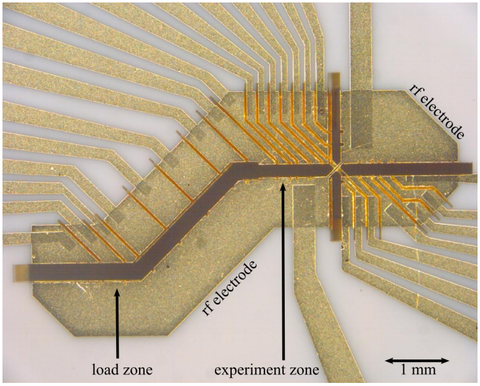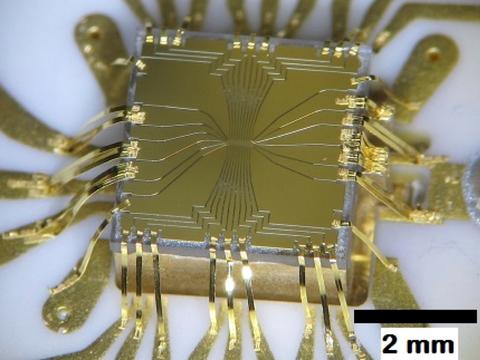Summary
The coherent control of quantum-mechanical systems holds promise for revolutionizing computing. We develop new methods and technologies to improve the fidelity and scalability of quantum control and readout for quantum computing based on trapped ions in radio-frequency traps.
Description
Quantum Computing with Trapped Ions
We pursue proof-of-concept experiments in quantum information processing and quantum control with trapped ions. In addition to pushing current limits on traditional quantum gate-based architectures for quantum computing we explore alternative approaches to entanglement generation and quantum information processing including microwave-based quantum gates and quantum simulation in 2-D arrays of rf microtraps.

In one experiment we make use of a segmented three-dimensional Paul trap (Fig. 1) in which we confine magnesium and beryllium ions in linear arrays. The trap features two trapping zones to split and recombine ion crystals and an X-shaped junction, which can be used to reorder ions in a linear array [1]. We have demonstrated several elements of a scalable quantum information processor in this and similar traps, including fast, low-excitation transport [2] and a high-fidelity universal gate set [3]. In particular, we achieved single-qubit operations at a fault-tolerant level (with less than one error in 25000 operations) and two-qubit entangling operations with less than one error in 1000 operations. We have also demonstrated multi-species entangling operations between a magnesium and a beryllium ion [4], which are an integral part of a possible future trapped ion quantum computer.

As an alternative to conventional laser-based quantum gates, we are also investigating microwave-driven gates [5]. This approach avoids a fundamental error source due to photon scattering and may be technologically easier to scale-up. In addition, breaking away from the traditional segmented linear traps, we develop micro-fabricated surface-electrode traps (Fig. 2) that enable flexible 2D geometries, and tunable interactions, which are useful for quantum computing and quantum simulation [6, 7]. Large-scale devices will need new methods for quantum state readout. In collaboration with colleagues at NIST, we are developing highly efficient superconducting photon detectors that are integrated into ion traps as part of the micro-fabrication process.
[1] R. B. Blakestad et al., "Near-ground-state transport of trapped-ion qubits through a multidimensional array", Phys. Rev. A 84, 032314 (2011)
[2] R. Bowler et al., "Coherent Diabatic Ion Transport and Separation in a Multizone Trap Array", Phys. Rev. Lett. 109, 080502 (2012)
[3] T. R. Tan et al., "Multi-Element Logic Gates for Trapped-Ion Qubits", Nature 528, 380 (2015)
[4] J. Gaebler et al. "High-Fidelity Universal Gate Set for 9Be+ Ion Qubits", Phys. Rev. Lett. 177, 060505 (2016)
[5] C. Ospelkaus et al., "Microwave quantum logic gates for trapped ions", Nature 476, 181 (2011)
[6] S. Seidelin et al., "A microfabricated surface-electrode ion trap for scalable quantum information processing", Phys. Rev. Lett. 96, 253003 (2006)
[7] A.C. Wilson et al., "Tunable spin-spin interactions and entanglement of ions in separate controlled potential wells", Nature 512, 57 (2014)

